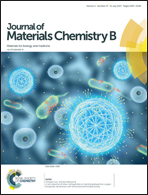A glucose-activatable trimodal glucometer self-assembled from glucose oxidase and MnO2 nanosheets for diabetes monitoring†
Abstract
Daily monitoring of blood glucose is of great importance for the treatment of diabetes mellitus. Herein, we present an ensemble glucometer with a sandwich structure formed by the spontaneous entrapment of glucose oxidase (GOD) onto manganese dioxide nanosheets (MnO2 NSs) via the hydrophobic effect and hydrogen bond interaction. Within the hybrid glucometer, the ultrathin MnO2 NSs act as an enzyme nanosupport and target-activated signal transducer. Trimodal self-indication by fluorescence (FL) and UV-absorbance (UV) and magnetic resonance signal (MRS) activation with glucose-specificity provides multiple response signals to glucose. Taking account of its operational simplicity and convenience, even being observable by the naked eye, a detection limit as low as 0.1 µM was obtained by using the ensemble glucometer in a colorimetric assay, whilst the precision for 11 replicated detections of 10 µM glucose was 3.5% (relative standard deviation, RSD). Notably, the value of the Michaelis–Menton constant of GOD involved the presented glucometer is estimated to be 0.051 mM, showing an exceptional enhanced enzymatic activity of free GOD measured by far. The designed glucometer, with its high sensitivity and simplicity highlighted, was capable of routine blood glucose monitoring for type-I diabetes mellitus in rats. Furthermore, the fully integrated platform can be readily generalized in principle for a number of biomarkers for point of care diagnostics in the future.



 Please wait while we load your content...
Please wait while we load your content...